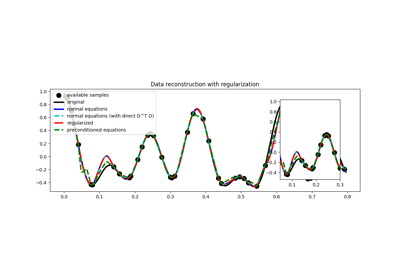pylops.optimization.sparsity.SPGL1¶
-
pylops.optimization.sparsity.SPGL1(Op, data, SOp=None, tau=0, sigma=0, x0=None, **kwargs_spgl1)[source]¶ Spectral Projected-Gradient for L1 norm.
Solve a constrained system of equations given the operator
Opand a sparsyfing transformSOpaiming to retrive a model that is sparse in the sparsyfing domain.This is a simple wrapper to
spgl1.spgl1which is a porting of the well-known SPGL1 MATLAB solver into Python. In order to be able to use this solver you need to have installed thespgl1library.Parameters: - Op :
pylops.LinearOperator Operator to invert
- data :
numpy.ndarray Data
- SOp :
pylops.LinearOperator Sparsyfing transform
- tau :
float Non-negative LASSO scalar. If different from
0, SPGL1 will solve LASSO problem- sigma :
list BPDN scalar. If different from
0, SPGL1 will solve BPDN problem- x0 :
numpy.ndarray Initial guess
- **kwargs_spgl1
Arbitrary keyword arguments for
spgl1.spgl1solver
Returns: - xinv :
numpy.ndarray Inverted model in original domain.
- pinv :
numpy.ndarray Inverted model in sparse domain.
- info :
dict Dictionary with the following information:
tau, final value of tau (see sigma above)rnorm, two-norm of the optimal residualrgap, relative duality gap (an optimality measure)gnorm, Lagrange multiplier of (LASSO)stat, final status of solver1: found a BPDN solution,2: found a BP solution; exit based on small gradient,3: found a BP solution; exit based on small residual,4: found a LASSO solution,5: error, too many iterations,6: error, linesearch failed,7: error, found suboptimal BP solution,8: error, too many matrix-vector products.
niters, number of iterationsnProdA, number of multiplications with AnProdAt, number of multiplications with A’n_newton, number of Newton stepstime_project, projection time (seconds)time_matprod, matrix-vector multiplications time (seconds)time_total, total solution time (seconds)niters_lsqr, number of lsqr iterations (ifsubspace_min=True)xnorm1, L1-norm model solution history through iterationsrnorm2, L2-norm residual history through iterationslambdaa, Lagrange multiplier history through iterations
Raises: - ModuleNotFoundError
If the
spgl1library is not installed
Notes
Solve different variations of sparsity-promoting inverse problem by imposing sparsity in the retrieved model [1].
The first problem is called basis pursuit denoise (BPDN) and its cost function is
\[\|\mathbf{x}\|_1 \quad \text{subject to} \quad \left\|\mathbf{Op}\,\mathbf{S}^H\mathbf{x}-\mathbf{b}\right\|_2^2 \leq \sigma,\]while the second problem is the ℓ₁-regularized least-squares or LASSO problem and its cost function is
\[\left\|\mathbf{Op}\,\mathbf{S}^H\mathbf{x}-\mathbf{b}\right\|_2^2 \quad \text{subject to} \quad \|\mathbf{x}\|_1 \leq \tau\][1] van den Berg E., Friedlander M.P., “Probing the Pareto frontier for basis pursuit solutions”, SIAM J. on Scientific Computing, vol. 31(2), pp. 890-912. 2008. - Op :
